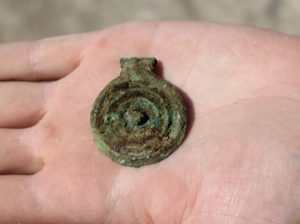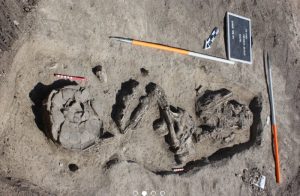An extraordinary discovery is reported from the area of Mány, a town in Hungary located in the northeast of Fejér County, Hungary.Preliminary excavations began at the beginning of summer on the route of the future M100 highway in the region. During the first few weeks of the archaeological diggings, archaeologists from the Szent István Király Museum discovered a part of an ancient cemetery with a small number of graves dated to the Bronze Age mound culture.

“We were basically expecting objects from the Middle Ages, but we also found a relatively small number of Bronze Age cemeteries,” informed the archaeologists, as cited by Fehérvár Médiacentrum
The team had already excavated eight burials, and the archaeologists were able to document a lot of beautiful accessories and clothing items.One of the most interesting findings is the grave of a young and most probably very rich girl around 20. According to the researchers, the tomb had so many attachments, which makes it unique because, essentially, we can reconstruct her clothing almost entirely.
This knowledge significantly expands information about Bronze Age clothing and different objects these ancient people used, explained Csilla Líbor, archaeologist and anthropologist who led the excavations.The burial was found full of jewelry that included 38 gold and bronze decorative objects, such as neck torques, rings, spiral epaulettes, gold hair rings, and a number of small ceramic vessels.
According to researchers, the woman was buried with rings on each finger, indicating that she was a wealthy person with a high social status in her community, writes Chechia Posts English.No doubt, the objects attest to an advanced knowledge of metalworking of these ancient people. Moreover, the findings reveal new insights into the clothing and accessories worn by people who inhabited the city of Mány thousands of years ago.Archaeologists who consider the site as remarkably rich in artifacts, also found traces of settlement dated to the Bronze Age and settlements from the Arpád period, which date from the 9th and 10th centuries AD.

“The simplicity and nobility of these objects are impressive. It’s exciting to think that they were made thousands of years ago,” said Zsolt Lehrner. The deputy mayor visited the restorer’s workshop and pointed out that the objects were surprisingly modern.
“We can never know what is hidden underground. The technology is already there so that we can identify certain things, but such finds are only brought to the surface during archaeological excavations or during metal detector research. If there were no archaeological excavations prior to major investments, then surely many such objects would be destroyed or never come to light.” commented Krisztián Pokrovenszki, director of the Szent István Király Museum.
The finds have been sent to the restoration workshop of the Szent István Király Museum in Székesfehérvár.